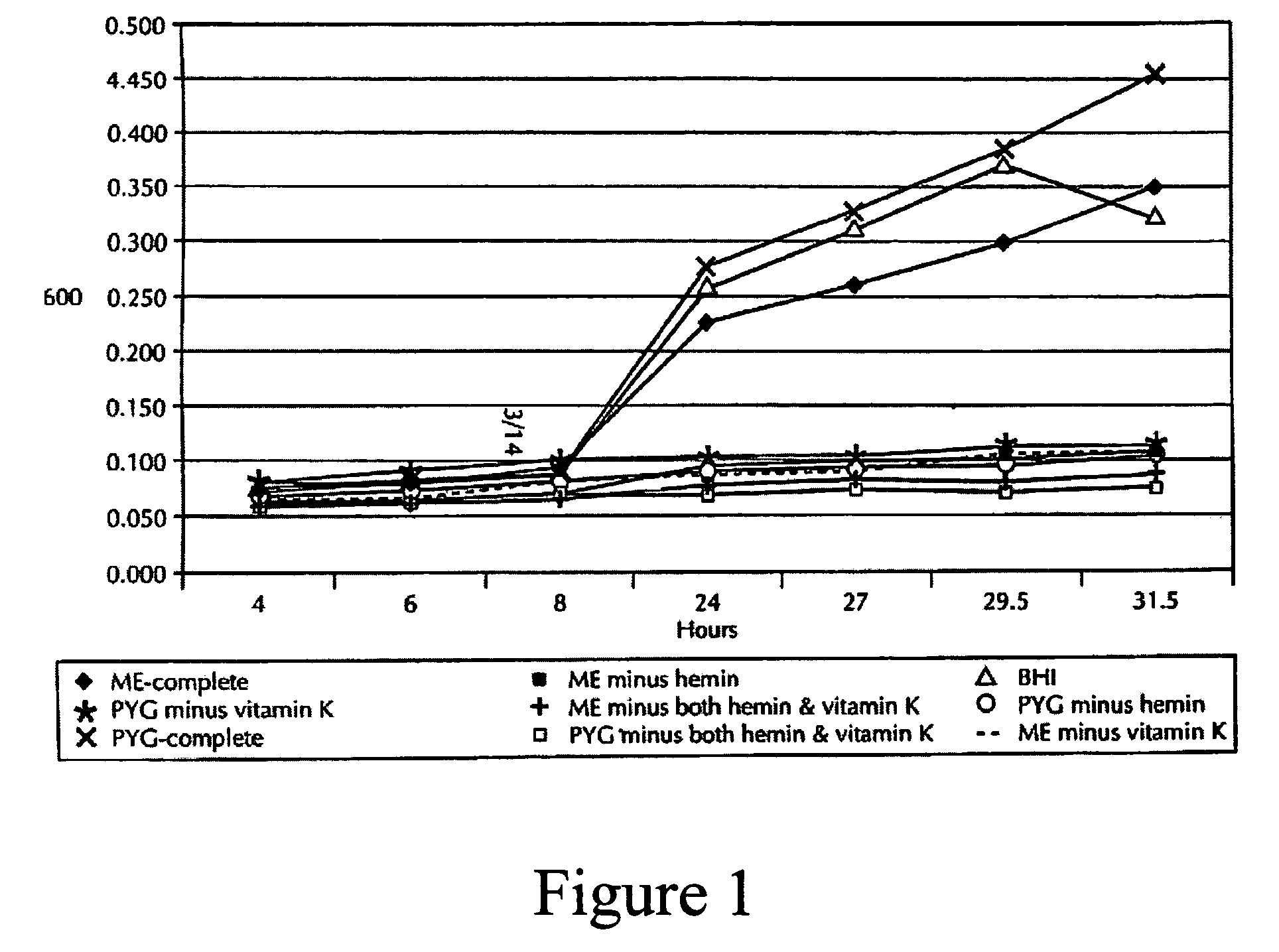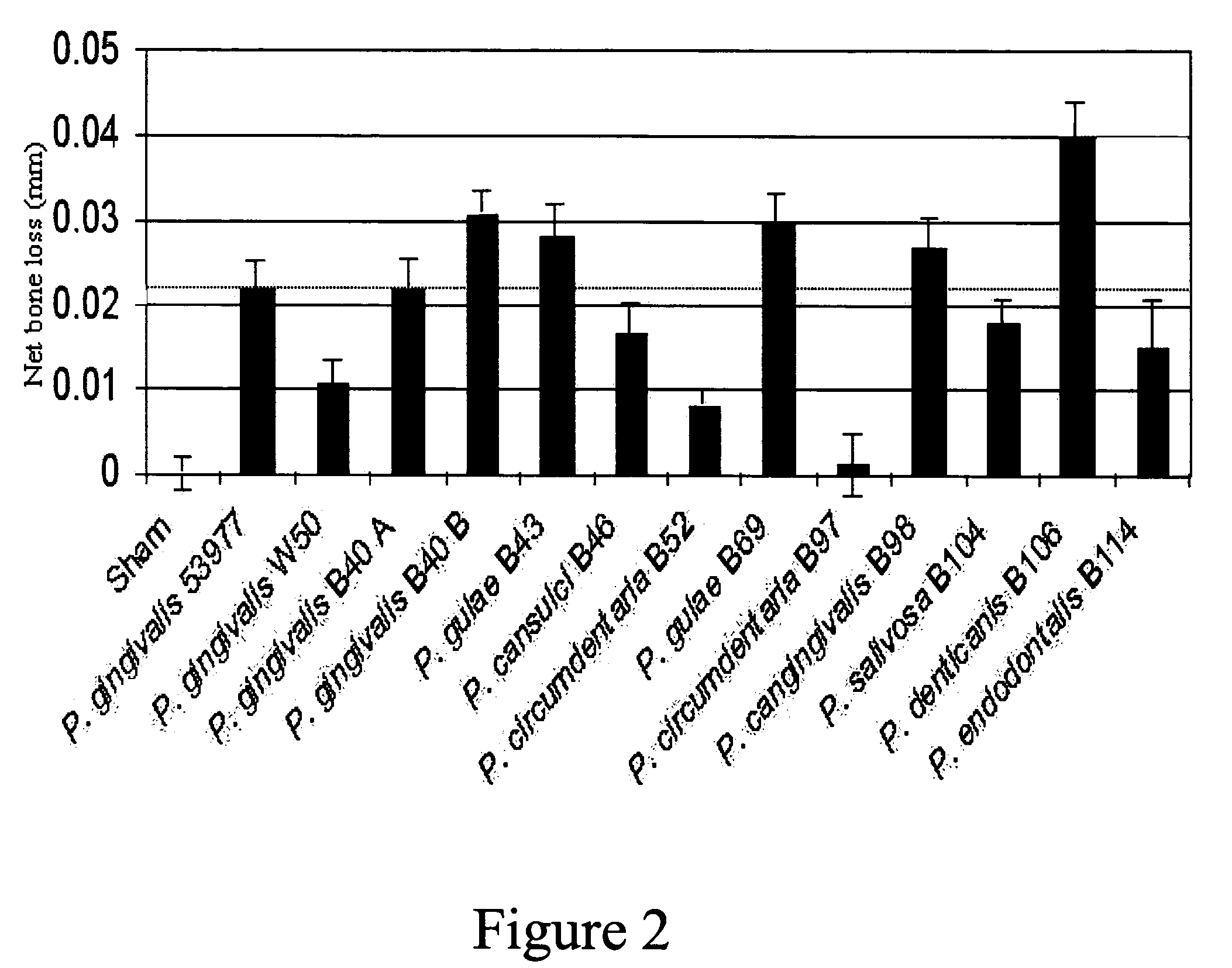Vaccine for periodontal disease
a periodontal disease and vaccine technology, applied in the field of bacteria isolates, can solve the problems of no evidence of vaccines effective in preventing periodontal disease in companion animals, complicated human pathogenesis study, and inability to detect and treat periodontal disease, etc., and achieve little in the way of preventing or treating the disease, even in humans
- Summary
- Abstract
- Description
- Claims
- Application Information
AI Technical Summary
Benefits of technology
Problems solved by technology
Method used
Image
Examples
example 1
Companion Animal Crevicular Fluid Sample
[0170]Microbial samples were taken from dogs and cats examined at veterinary clinics for periodontal treatment, or dogs examined at either Pfizer Terre Haute or Pfizer Sandwich facilities for normal check-ups. Dogs with periodontal pockets >3 mm and cats with periodontal pockets >2 mm were included in this study. Dental indices (gingival index and periodontal index) and the periodontal pocket depths were recorded. Individual coarse absorbent paper points (Henry Schein; Melville, N.Y.) were aseptically inserted into the periodontal pocket. Upon removal, the paper points were immediately inserted into vials containing Pre-Reduced Anaerobically Sterile (PRAS) Anaerobic Dental Transport (ADT) Medium (Anaerobe Systems; Morgan Hills, Calif.).
[0171]Vials were transferred into a Bactron IV anaerobic chamber (Sheldon Manufacturing, Cornelius, Oreg.) and processed under 90% N2, 5% H2, 5% CO2. The paper points were aseptically placed into 50 μl of PRAS B...
example 2
[0219]Ten beagle dogs with adult dentition were used for this study. The animals were anesthetized, and an access was made to the root canal of the mandibular premolars and first molars using a pear-shaped dental burr (Midwest Dental Products Corp; Des Plaines, Ill.) in a Schein Ultima 2000 dental unit with a high-speed handpiece (Henry Schein Inc.; Melville, N.Y.). Access to the root canal was confirmed by passing a veterinary barbed broach (21 mm, size #5; Roydent Dental Products; Johnson City, Tenn.) into the canal to a depth approximating the depth of the root canal. The connective tissue, vessels and nervous tissue were removed using repeated passages of the barbed broach. Hemorrhaging was minor; hemostasis was achieved with sterile paper points (Henry Schein Inc.) placed in the canal. It was important at this point to ensure that any inadvertent contamination of the canal during the drilling and emptying of the canal was removed. Therefore the canal was flushed with a 10% blea...
example 3
[0223]Following model development, a study was conducted in dogs to test the efficacy of a trivalent vaccine preparation. The trivalent bacterin contained formalin-inactivated Porphyromonas gulae (B43), Porphyromonas salivosa (B104), and Wernerella denticanis (B106), adjuvanted with Quil A and cholesterol at 50 μg of each per dose. Each bacterin strain was assembled at an approximate concentration of 1×1010 CFU / vaccine dose. Three groups of eight animals with adult dentition were used in this study. Dogs in the first group (T01) were vaccinated intramuscularly (IM) with 1 ml of the trivalent vaccine. The second (T02) and third (T03) groups were sham vaccinated with 1 ml of sterile saline. All dogs received three intramuscularly (IM) administrations, with a three week interval between administrations. Three weeks following the final administration, animals were anaesthetized as described above, and the challenge material was introduced into the root canal of the mandibular premolars ...
PUM
| Property | Measurement | Unit |
|---|---|---|
| temperature | aaaaa | aaaaa |
| weights | aaaaa | aaaaa |
| volume | aaaaa | aaaaa |
Abstract
Description
Claims
Application Information
 Login to View More
Login to View More - R&D
- Intellectual Property
- Life Sciences
- Materials
- Tech Scout
- Unparalleled Data Quality
- Higher Quality Content
- 60% Fewer Hallucinations
Browse by: Latest US Patents, China's latest patents, Technical Efficacy Thesaurus, Application Domain, Technology Topic, Popular Technical Reports.
© 2025 PatSnap. All rights reserved.Legal|Privacy policy|Modern Slavery Act Transparency Statement|Sitemap|About US| Contact US: help@patsnap.com



